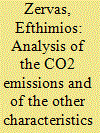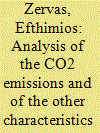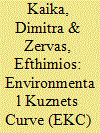|
|
|
Sort Order |
|
|
|
Items / Page
|
|
|
|
|
|
|
| Srl | Item |
| 1 |
ID:
098557


|
|
|
|
|
| Publication |
2010.
|
| Summary/Abstract |
Exhaust CO2 emitted from passenger cars is one of the major greenhouse effect gases. Several parameters influence the exhaust CO2 emissions of each passenger car: its characteristics (fuel used, vehicle weight, …) and its use (annual mileage, driving conditions, …). CO2 emissions from passenger cars decrease during last years; however, this decrease seems to reach its limits. Several parameters of the EU15 new PCs market, such as new passenger cars registrations, type of fuel used, engine capacity, max. power, max. specific power, segment distribution, vehicle weight and their CO2 emissions on the New European Driving Cycle are analyzed here. The target is to find the real market parameters influencing exhaust CO2 emissions. Because of the many data used and the parameters examined, this first part of the work is focused on the average values of each parameter studied and the values of each country, while the second part is based on the analysis of each PC segment and the third one on the analysis of the major brands presented in the European market.
|
|
|
|
|
|
|
|
|
|
|
|
|
|
|
|
| 2 |
ID:
098559


|
|
|
|
|
| Summary/Abstract |
This article analyzes the engine and vehicle characteristics and the CO2 emissions of the new passenger cars for all segments of the European market. As in the first article of this work, the target is to find the real market parameters influencing exhaust CO2 emissions. The present analysis is focused on the segment sales distribution (EU average and within each country) and also in four parameters of each segment influencing CO2 emissions: average vehicle weight, average engine capacity, average maximum and specific power. The second part of this work concerns the CO2 emissions of each segment on the New European Driving Cycle and its urban and extra urban parts.
|
|
|
|
|
|
|
|
|
|
|
|
|
|
|
|
| 3 |
ID:
110719


|
|
|
|
|
| Publication |
2011.
|
| Summary/Abstract |
Transport is the second emitter of CO2 in the European Union, after the energy production sector, with constantly increased trend. European Union proposed the regulation 443/2009 to control the CO2 emissions from new passenger cars. According to that regulation, the average, for each car manufacturer, CO2 emissions of the new passenger cars registered in 2020 in European Union should not exceed the value of 95 g CO2/km on the New European Driving Cycle. In the present work the regulation 443/2009 is analyzed and a critique is addressed to four points. The first point concerns the average upper limit of CO2 emissions of each car manufacturer. The second point concerns the possible derogation for the low volume manufacturers and the third to the penalties for the extra CO2 emissions. The fourth point concerns the value of the proposed average upper limit of CO2 emissions and the possibility to be changed in the future. A change to the above points is proposed. The maximum decrease of CO2 emissions and the principle of equality of citizens are the two principles of our propositions for the CO2 regulations.
|
|
|
|
|
|
|
|
|
|
|
|
|
|
|
|
| 4 |
ID:
125854


|
|
|
|
|
| Publication |
2013.
|
| Summary/Abstract |
According to the environmental Kuznets curve (EKC) theory, the process of economic growth is expected to limit the environmental degradation created in the early stages of development. The first article of this study reviews the empirical studies examining various factors, other than income, that may lead to an EKC-pattern. The current article reviews in the first part the major critiques on the EKC-speculation which relate to the following issues: the normal distribution of world income, the feedback from environmental degradation to economic growth, the characteristics of the pollutant in question, various econometric issues, the evolution of consumption when income rises and the assumption about a common developmental pattern in all countries. The second part discusses additional matters reported indirectly in the literature and/or must be further examined. There are doubts whether the GDP-series captures the transition of production to the three productive sectors in empirical estimations and whether services are less polluting compared to industry activities. Finally, the original Kuznets-theory, which laid the groundwork for the EKC-concept, does not seem to solve income inequality problems.
|
|
|
|
|
|
|
|
|
|
|
|
|
|
|
|
| 5 |
ID:
125853


|
|
|
|
|
| Publication |
2013.
|
| Summary/Abstract |
The main purpose of this study is to capture the main features of the Environmental Kuznets Curve (EKC)-concept. According to the EKC-theory, the process of economic growth is expected eventually to limit the environmental degradation created in the early stages of development. The EKC concept leads many researchers from the early 1990s to assume that each economy should focus on its growth, and any environmental problems will be eventually eliminated by the process of economic growth. Several studies attempt to test empirically the EKC-hypothesis using data on many countries and examining various types of environmental degradation, while other studies examine the underlying factors that may drive such a relationship. This article reviews the evolution of the EKC-concept and the possible causes of an EKC-pattern, like the distribution of income, the international trade (pollution haven hypothesis), structural changes, technical progress and improvements in energy efficiency, institutions and governance and consumer preferences. As CO2 emissions are a pollutant with global effects, several studies deal with the possible EKC-pattern for CO2 emissions and these studies are discussed separately. The various critiques on the EKC-concept are reviewed in the second article of this work.
|
|
|
|
|
|
|
|
|
|
|
|
|
|
|
|
| 6 |
ID:
096714


|
|
|
|
|
| Publication |
2010.
|
| Summary/Abstract |
The public acceptance of biofuels in Greece is examined in this work. The analysis of 571 face to face interviews shows that 90.7% of the respondents believe that climatic changes are related to fossil fuel consumption, while only 23.8% know the difference between biodiesel and bioethanol. 76.1% believe that energy saving should precede the use of an alternative source of energy. Only 27.3% believe that priority must be given to biofuels over other renewable energy sources. Only 49.9% think that the use of biofuels can be an effective solution against climatic changes and 53.9% believe that the use of biofuels can be an effective solution for the energy problem. Finally, 80.9% of the car owners are willing to use biofuels, 44.8% are willing to pay the supplementary amount of 0.06 €/L of the fuel market price, while the average amount reported as willing to pay was 0.079 €/L on top of the fuel market price. Furthermore, eight models correlating the eight main responses with several socioeconomic variables are developed and analyzed. Those findings heave important policy implications related to the use and promotion of biofuels.
|
|
|
|
|
|
|
|
|
|
|
|
|
|
|
|
| 7 |
ID:
097507


|
|
|
|
|
| Publication |
2010.
|
| Summary/Abstract |
The public acceptance of biofuels in Greece is examined in this work. The analysis of 571 face to face interviews shows that 90.7% of the respondents believe that climatic changes are related to fossil fuel consumption, while only 23.8% know the difference between biodiesel and bioethanol. 76.1% believe that energy saving should precede the use of an alternative source of energy. Only 27.3% believe that priority must be given to biofuels over other renewable energy sources. Only 49.9% think that the use of biofuels can be an effective solution against climatic changes and 53.9% believe that the use of biofuels can be an effective solution for the energy problem. Finally, 80.9% of the car owners are willing to use biofuels, 44.8% are willing to pay the supplementary amount of 0.06 €/L of the fuel market price, while the average amount reported as willing to pay was 0.079 €/L on top of the fuel market price. Furthermore, eight models correlating the eight main responses with several socioeconomic variables are developed and analyzed. Those findings heave important policy implications related to the use and promotion of biofuels.
|
|
|
|
|
|
|
|
|
|
|
|
|
|
|
|
| 8 |
ID:
119817


|
|
|
|
|
| Publication |
2013.
|
| Summary/Abstract |
In the present study, Data Envelopment Analysis is used to determine the Technical Efficiency index of EU-15 countries from 1980 to 2008, using cross-country comparison. Technical Efficiency index represents the capacity of an economy to produce a higher level of Gross Domestic Product for a given level of total energy input. The level of the Technical Efficiency index is determined from the energy mix (fossil fuels, non-fossil fuels, nuclear energy) of each country and depends on the maximization level of the production of the Gross Domestic Product of the economic system, without waste of energy resources. The current study is applied in the case of the EU15 countries. Its scope is to highlight the differentiations of country classifications before and after the integration of nuclear energy in the energy mix of each country. The main result is that the integration of nuclear energy as an additional input in the energy mixture affects negatively the Technical Efficiency of countries. Also, when an economy achieves a decrease of the energy consumption produced from fossil fuels, and a better exploitation of renewable energy sources, clearly improves its capacity to produce more output with the given levels of inputs.
|
|
|
|
|
|
|
|
|
|
|
|
|
|
|
|
|
|
|
|
|